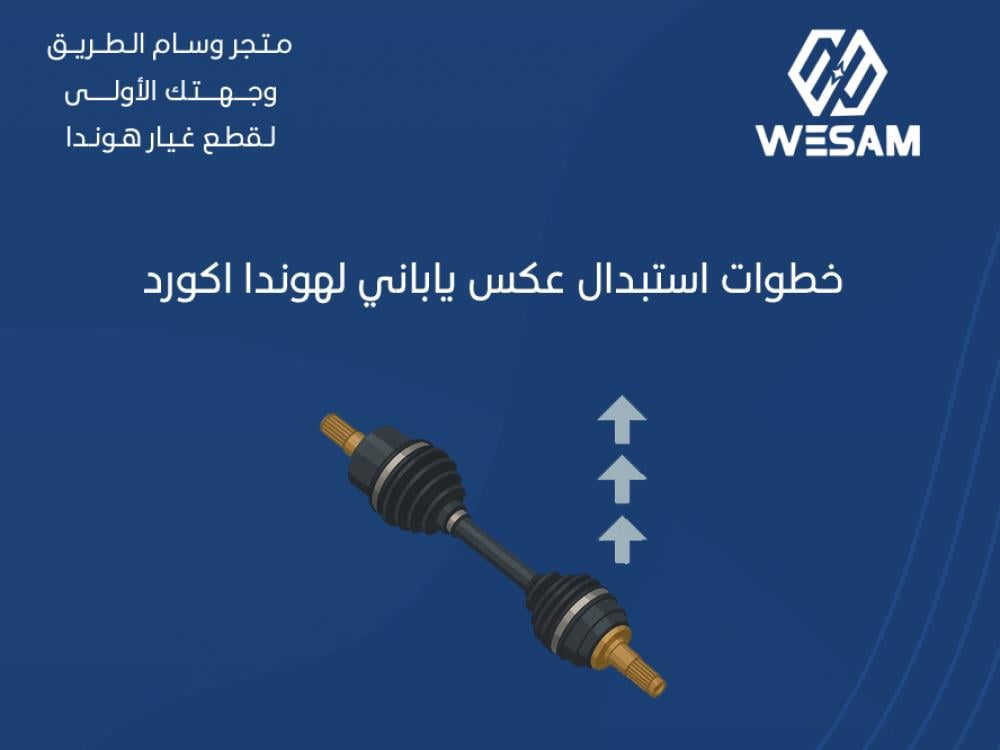Learn the steps to replace a Japanese CV axle (drive shaft) for a Honda Accord in detail, with an explanation of the differences between an original Accord CV axle and aftermarket ones, the symptoms of a failing Accord axle, and tips for choosing a genuine axle that lasts long.
The CV axle is one of the essential parts of the front-wheel-drive system, particularly in the Honda Accord, which relies on balanced performance and high stability. The axle is the component that transfers power from the transmission (gearbox) to the wheels, enabling the front wheels to rotate while driving. In this article, we’ll walk through the steps of replacing a high-quality Japanese Accord axle, highlighting its importance, the differences between genuine and aftermarket versions, and the best tips for choosing the right part.
What is the CV axle in a car?
The CV axle (drive shaft) is a critical component of the front-wheel-drive system. It transmits power from the transmission to the wheels. The axle usually contains flexible joints that allow it to adapt to suspension movement when driving on uneven roads. In vehicles like the Honda Accord, the axle plays a vital role in maintaining balance and stable power delivery, especially during cornering or gear shifts.
The CV axle is equipped with a rubber boot that protects the joint from dirt and grease leaks. Once the boot is damaged, wear begins and may lead to complete joint failure.
In technical terms, the drive shaft (CV axle) is a mechanical shaft installed between the transmission and the front wheel. It usually consists of a metal arm with an inner and outer joint, protected by a rubber boot. In front-wheel-drive cars like the Accord, there are two axles—one on each side—each transmitting power to the wheel while allowing rotation and flexibility during steering or when going over bumps.
Why choose a genuine Honda Accord axle?
Relying on a genuine or high-quality Japanese Accord axle ensures not only smooth driving but also your safety during daily use or long trips. Genuine and Japanese axles undergo strict durability testing and precision manufacturing, minimizing the risk of sudden failure or grease leaks. They also deliver consistent performance with the suspension and steering system—something aftermarket copies don’t always guarantee.
Benefits of a genuine Honda Accord axle:
Stable performance at all speeds.
No steering wheel or body vibrations during acceleration.
Longer lifespan compared to aftermarket axles.
Reduced risk of premature joint or boot failure.
While cheaper aftermarket options exist, an original or Japanese-quality Accord axle remains the best choice for safe, smooth driving.
Signs of a failing Honda Accord axle
Common symptoms that indicate it’s time to replace the axle include:
Clicking or popping noises when turning right or left.
Vehicle vibrations during acceleration or at high speeds.
Grease leakage around the axle ends.
Torn or damaged rubber boot.
Shaking when braking or maneuvering.
If you notice any of these issues, inspect the axle immediately to prevent further damage to the suspension or transmission.
Original vs. Aftermarket Accord axle
It’s important to understand the differences before buying:
Original axle: Manufactured to Honda’s strict standards, using treated metals and high-quality protected joints. It offers a longer lifespan and smooth performance without vibrations or noise.
Aftermarket axle: Available in many varieties—some acceptable, others poor quality. While usually cheaper, they often wear out faster and may require cutting or fitting adjustments, which can affect the car’s alignment.
Always buy your Accord axle from a trusted source to ensure boot quality and joint durability—cheap versions often fail within months.
Steps to replace a Honda Accord axle (Japanese type)
1. Prepare the vehicle
Lift the car on a flat surface using a jack.
Secure the rear wheels.
Disconnect the battery.
2. Remove the front wheel
Loosen and remove the wheel nuts using a torque wrench.
Take off the wheel completely.
3. Free the suspension system
Remove the ball joint nut and strut bolts.
Gently release the lower control arm using a pry bar to move the strut aside.
4. Remove the damaged axle
Disconnect the axle from the hub and transmission.
If stuck, use a pry bar or long screwdriver to carefully release it from the gearbox.
5. Install the new axle
Insert the inner end into the transmission until you hear a “click.”
Attach the other end to the wheel hub and tighten the nuts.
6. Reassemble and test
Reinstall the control arm, strut, and wheel.
Lower the car.
Start the engine and test-drive at low speed to ensure no noises or vibrations.
Tips when buying a Honda Accord axle
Don’t rely on looks—verify the part number matches your car’s VIN.
Avoid untested aftermarket axles with no warranty.
Check the boot material—it’s often the weakest point.
Prefer factory-greased axles to save installation time.
Test the joints manually—they should move smoothly without resistance or clicking.
A genuine or high-quality Japanese Accord axle saves you extra costs in repeated replacements.
Where to buy a Honda Accord axle?
The best option is a specialized store like Wesam Store, which offers:
A variety of genuine and Japanese axles.
Technical support to help you choose the right part.
Fast shipping within the Kingdom.
Both in-store and online purchase options.
Wesam’s team also assists in verifying part numbers and providing professional advice.
When to inspect the axle?
Every 40,000 km if driving on rough roads.
Whenever you hear unusual noises when turning.
If you notice reduced stability or grease leaks under the engine.
FAQs
Can I replace the axle without a jack?
It’s best to use a jack for safety and space.
Can I use a used axle?
It may work temporarily but is not reliable long-term.
How much does an Accord axle cost?
Genuine axle: 900–1500
Japanese aftermarket: 600–900
Conclusion
Replacing the Accord axle isn’t just a repair—it’s an essential step to maintain driving safety and stability, especially with daily use and frequent bumps or turns. Always inspect the axle regularly and buy a genuine or trusted Japanese one from an authorized dealer like Wesam.
By following this guide, you can ensure a proper installation and long-lasting performance. The CV axle is a core element of the drivetrain and steering system, and any failure directly affects driving safety. Replacing your Honda Accord axle with a genuine or Japanese part is a smart investment in comfort and safety.

